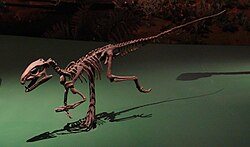Pisanosaurus
|
Pisanosaurus Temporal range: Late Triassic, 228–216.5 Ma |
|
|---|---|
 |
|
| Display at the Royal Ontario Museum | |
| Scientific classification | |
| Kingdom: | Animalia |
| Phylum: | Chordata |
| Class: | Reptilia |
| Clade: | Dinosauria |
| Order: | †Ornithischia |
| Family: |
†Pisanosauridae Casamiquela, 1967 |
| Genus: |
†Pisanosaurus Casamiquela, 1967 |
| Species: | †P. mertii |
| Binomial name | |
|
Pisanosaurus mertii Casamiquela, 1967 |
|
Pisanosaurus (pron.:"PIE-san-uh-SAWR-us") is an extinct genus of primitive ornithischian dinosaur that lived approximately 228 to 216 million years ago during the latter part of the Triassic Period in what is now South America. It was a small, lightly-built, ground-dwelling, bipedal herbivore, that could grow up to an estimated 1 m (3.3 ft) long. Only one species, the type, Pisanosaurus mertii, is known, based on a single partial skeleton discovered in Argentina's Ischigualasto Formation.
The exact classification of Pisanosaurus has been the topic of debate by scientists for over 40 years; the current consensus is that Pisanosaurus is the oldest known ornithischian, part of a diverse group of dinosaurs which lived during nearly the entire span of the Mesozoic Era.
Based on the known fossil elements from a partial skeleton, Pisanosaurus was a small, lightly built dinosaur approximately 1 m (3 ft 3 in) in length. Its weight was between 2.27–9.1 kg (5–20 lb). These estimates vary due to the incompleteness of the holotype specimen PVL 2577. The orientation of the pubis is uncertain, with some skeletal reconstructions having it projecting down and forward (the propubic condition) similar to that of the majority of saurischian dinosaurs. The tail of Pisanosaurus has been reconstructed as being as long as the rest of the body, based on other early ornithischians, but as a tail has not been recovered, this is speculative. It was bipedal and, like all other known ornithischians, was probably herbivorous.
...
Wikipedia
